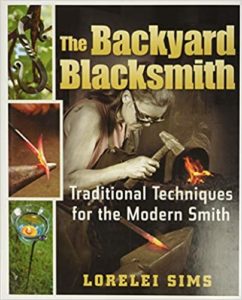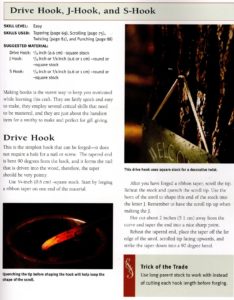The Backyard Blacksmith: Traditional Techniques for the Modern Smith
By: Lorelei Sims – Published: 2009

Price : $ – Amazon
Philip’s Ranking: 5
Beginner Blacksmith: 5
Advanced Blacksmith: 0
Inspiration: 0
Historical: 0
Video Review: N/A
This is one of the first blacksmithing books I ever purchased and I still think it’s one of the best beginner blacksmithing books out there for a couple reasons.
- The book is dirt cheap at ~$10 for a new hardcover copy
- The book is well written, clear, and to the point.
- The mix of illustrations, photos, and breakout boxes does a great job of supplementing and clarifying the main text.
- The lessons and sample projects are well organized, easy to follow, and appropriate for a beginner blacksmith.
Whenever someone new asks me what book they should get before they get into blacksmithing this is my recommendation. You will not find an equal book anywhere near the same price.
Lorelei starts off with the pretty standard setting up your smithy, safety equipment, an overview of blacksmithing tools, and what’s the difference between iron, wrought iron, cast iron, and steel. It’s all well presented and will take you from knowing nothing to being able to buy/make the right stuff to start off safely.
The book then moves on to Preliminary Skills focused on how to start & tend your fire, how to tell how hot your steel is and not burn it up, working with tongs, finding the right hammer, and breaking apart your, solid fuel, fire so it doesn’t burn your house/shop down.
Chapters 5, 6, & 7 are grouped to gether in a section called “Getting your hands dirty” focus on the key skills of blacksmithing and creating the essential blacksmithing tools. Chapter 5 covers the “easier” skills and focuses drawing out, upsetting, bending, cutting, and the use of standard hardy tools. All the techniques are covered in detail with accompanying illustrations to clearly show what is happening. Chapter 6 is then focused on forge welding and assemblage techniques including riveting, mortise and tenons, collars, and wraps. After reading through these chapters a new smith will have a solid idea of all of the core traditional blacksmithing skills.
Lorelei then wraps up the section with chapter 7 covering drifts, punches, twisting bars, hold fasts, hardy tools, monkey tools, and a few other very useful blacksmithing tools. She’s got the right selection of tools that a beginner will want and use. The only criticism I have is that a number of the tools require modern welding to make and if you don’t have that skill you won’t be able to make those tools.
 The final section “Getting in the groove” covers 17 projects that run the range from simple to moderately complex. There is nothing in the book that, with practice, a new blacksmith couldn’t make using the instructions and tools in the book.
The final section “Getting in the groove” covers 17 projects that run the range from simple to moderately complex. There is nothing in the book that, with practice, a new blacksmith couldn’t make using the instructions and tools in the book.
I’ve included an image of the first project from the book on the book on how to create a drive hook so you can get a good sense for why I like this book so much. As you can see the layout is great with a comment on the skill level of the project, what skills are used along with the reference pages for those skills.
The entire book is of this same quality and it makes it extremely easy to use.
If you’re considering getting into blacksmithing buy this book as your first purchase.
If you’re an experienced blacksmith buy this book to loan to any friends who say they want to get into blacksmithing. If they don’t return it you’re only out $10.